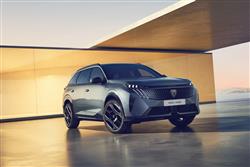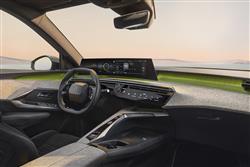Peugeot 5008 - ABC Leasing
FIVE COMES ALIVE(some text hidden)
By Jonathan Crouch
Ten Second Review word count: 42
Peugeot has reinvented its seven-seat 5008 SUV in this third generation form. Thanks to the new STLA platform, there's now a full-EV version - and a Plug-in Hybrid. Plus the cabin's been completely redesigned and pushed up-market. Family transport just got upgraded.
Background word count: 157
What kind of car should a family seven-seater be? MPV or SUV? Peugeot's changed its mind on that over the last few decades, originally launching its three-seating-row contender, the 5008, in 2010 as an MPV people carrier. The second generation version of 2017 though, morphed into a trendier-looking SUV and that approach continues with the MK3 model we're looking at here, introduced in 2024. Like its two predecessors, it's basically just a stretched, boxier version of the brand's 3008 mid-sized SUV. Which means that this time round, it can also be had in full electric E-5008 form, courtesy of the new STLA platform that now undergirds this third generation design. A 48V Hybrid version's being offered. And a Plug-in Hybrid variant for the first time too. The 5008 remains Peugeot's answer to cars like Skoda's Kodiaq and Nissan's X-Trail. And now provides stiffer competition for these two family SUV favourites. It ought to find a ready market.
Driving Experience word count: 382
A family-sized seven-seat SUV isn't meant to be thrown about. But it should be capable of safe, high speed handling, should circumstances demand that. If you want us to get right to it, that's what's been delivered here. Don't expect to particularly enjoy the back doubles on your way home from the school run. But if necessary, the 5008 will get you through them surprisingly quickly if your kids have made you late for your first appointment of the day. At the wheel, the unusual driving position of the 'i-Cockpit' design takes some getting used to, but does encourage wrist-flick direction changes aided by this Peugeot's relatively light weight by class standards. There are three main powertrain choices this time round. Arguably, all you really need is the base Hybrid 145 48V model, which has a 1.2-litre three cylinder petrol engine and a dual-clutch 6-speed auto gearbox with an integrated 22hp electric motor. This time round though, that unit is joined not by a diesel (that's been dropped) but by two powertrains you can plug in. The Plug-in Hybrid 195 version is based around a 150hp 1.6-litre petrol engine mated to a 21kWh battery that energises a 125hp electric motor; which claims to be to drive the car for up to 55 miles on the combined cycle on battery power. Rest to 62mph in the PHEV takes 8.3s en route to 137mph, which is 3 seconds and 14mph faster than the Hybrid 136 variant. The final alternative is the full-electric E-5008. In terms of EV powertrain, all you really need here is the 213hp 73kWh single motor E-5008 model that most customers will choose. It's not particularly fast for an EV, making 62mph in 9.7 seconds, but there's plenty of pulling power that makes the performance quite enough for family duties and eager enough for a 2.2-tonne family car. EV range is up to 310 miles. If you want to go further, there's a Long Range Single Motor model available with 231hp and a larger 97kWh battery that can take you up to 414 miles. At the top of the line-up is the Dual Motor Electric 325 model, which produces 325hp from its twin motors and also uses the 73kWh battery pack. Driving range with that variant is quoted at 289 miles.
Pictures (High res disabled)

.jpg)
.jpg)
.jpg)
.jpg)
.jpg)
.jpg)

Scoring
Category: Compact Car
| Performance | |
| Handling | |
| Comfort | |
| Space | |
| Styling | |
| Build | |
| Value | |
| Equipment | |
| Economy | 70% |
| Depreciation | 70% |
| Insurance | 60% |
| Total | 68% |